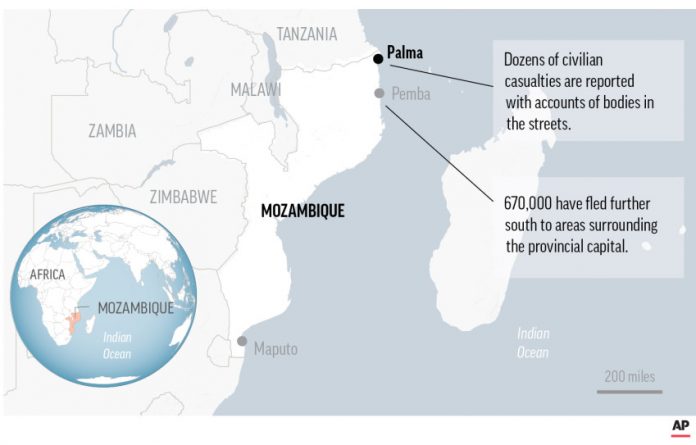“Victory comes from finding opportunities in problems.” – Sun Tzu
Dear Readers,
LONG TERM DAESH THREAT
While international forces have proved that coordinated kinetic might can defeat a militant force like Daesh when it is trying to hold a particular geographical area, such as the self-proclaimed Islamic State of Iraq and the Levant (ISIL), overcoming the idea of a worldwide caliphate is much more challenging.
Major General Kevin Copsey, deputy commander – Strategy, Combined Joint Task Force, Operation Inherent Resolve in Iraq, speaking during the Royal United Services Institute (RUSI) virtual conference, Lessons from Operation Inherent Resolve: From Ensuring the Enduring Defeat of ISIS to Stabilising the Region, held on Wednesday 7 April, said that defeating the concept of global authority over muslims which Daesh was trying foster would be much more of an enduring task.
Gen Copsey made the point that all the tools available to nation states – air, land, sea, cyber and space – would be required to work together and in unison if Daesh’s conceptual logic was to be faced down.
The growth of Daesh-linked attacks over an increasing number of vulnerable states in Africa, most recently in the town of Palma in Mozambique on the border with Tanzania, where dozens were killed as insurgents attacked the town, is a worrying development. Southwest African states now look vulnerable.
Daesh as a conceptual movement has been shown to arise in diverse locations and quickly adapt to the ruthlessness witnessed during its control of ISIL. There is also the threat of diverse elements unifying: the Islamic State in the Greater Sahara (ISGS), the Islamic State in West Africa Province (ISWAP) in Nigeria; and the Islamic State Central Africa Province (ISCAP) and militants in the Democratic Republic of Congo.
Dealing with this threat will take much more than kinetic force. It will require coalitions and military organisations not only to work together in terms of intelligence sharing to deliver kinetic effect, but there is a need to partner with the governments of countries facing Daesh destabilisation in order to tackle governmental corruption, as well as a lack of defined, funded and long term policies and objectives. There is also often a need to improve the basic training of national forces that have to stand in the front line against Daesh.
Editor
PHOTO QUIZ – SERVING A PURPOSE
Another set of pictures for you to consider – this time novel ways to fill a requirement. Again no prizes, but the answers are at the end of this email.
1)

2)

3)

ARISE INTERNATIONAL SPACE COMMANDS; BUT WHERE DO THEY FIT BETWEEN DEFENCE AND COMMERCE?

The question of how to position a space force in the context of a national alignment of capability, how to structure it and what it’s purpose was were questions discussed during a Royal United Service Institute (RUSI) virtual webinar entitled UK Space Command – What Can We Expect?
Alexandra Stickings, research fellow, Space Policy and Security, RUSI said that the United Kingdom was still at the beginning of its formal role in space, but would be able to formulate a position through discussions and collaborations with allies such as the United States, France and Japan “who have all started to establish formal space architectures within defence.”
Stickings also questioned how space would be integrated between the Royal Air Force (RAF) and other military commands, given that both of the current leadership roles within the UK Space Directorate and the UK Space Command were filled by senior RAF officers, Air Vice Marshal Harv Smyth and Air Commodore Paul Godfrey respectively.
As space is also both a commercial domain as well as a potential warfighting one, the UK needs to clarify the extent of its own ambitions in terms of assets as well as how these will be protected. Stickings expected some answers to be delivered in the upcoming National Space Strategy which is due to be published in June.
Victoria Samson, Washington Office director, Secure World Foundation, pointed to the number of countries looking to enhance their national security through the development of counter-space capabilities. This was increasing in five key areas: “deceive, disrupt, deny, degrade or destroy space systems. While this is not new, there is now a growing incentive for countries to develop these type of capabilities, including electronic warfare, directed energy and cyber. She continued that these that could also be used against commercial and civil space systems “upon which huge parts of the global society is dependent.”
Several countries are currently establishing and developing their own space commands/organisations. The US Space Command is likely to be the early leader with a domain that starts at 150km above the earth and beyond. Its mission is military in nature and has two subordinate commands. There is also the Space Force, founded in 2019, which is a separate military service but inside the US Air Force. It employs around 2,000 personnel but this number is likely to rise closer to 16,000.
In July 2019, France formed a full Space Command starting with 200 people but expanding up to 500 people. In will report to the Ministry of Defence. “This is intend to be responsible for all of France’s space operations under the command of the Chief of Staff of the Armed Forces,” said Samson. It will develop autonomy of action and the strategy will be defensive in nature.
Other nations with space commands include India which, in April 2019, established a Defence Space Agency to coordinate the needs of all three military services. It will be around the same size as the French organisation. In January 2020, Japan established a Space Domain Mission Unit which is intended to be fully operational by 2023. It will grow to around 100 personnel and will be part of Japan’s Air Self Defence Forces.
Trends for all of these agencies follow broadly similar lines in trying to determine space based threats and identify responses, understand situational awareness, integrate space within existing defence structures.
RUSSIAN FORCE BUILD-UP NEAR UKRAINE GIVES U.S. ‘REAL CONCERNS’, SAYS SECRETARY BLINKEN

The Russian military build up on the border with Ukraine is increasingly being reported with concern by a variety of news sources. The force build up is to the north and east of Ukraine and in the Crimea.
On Sunday 11 April US Secretary of State Antony Blinken, during a Meet the Press interview, stated: “We have real concerns about Russia’s actions on the borders of Ukraine. There are more Russian forces massed on those borders than at any time since 2014 when Russia first invaded the Crimea.” He added that President Biden had already stated that “if Russia acts recklessly or aggressively there will be consequences.” Last time such consequences took the form of sanctions rather than military action.
While Russia continues to play down the build up stating various reasons such as the build-up was only an exercise, White House press secretary Jen Psaki speaking on 2 April stated: “We’ve seen this movie before of the disinformation campaign that Russia has implemented in the past as it relates to their aggressions at the border of Ukraine.”
Ukraine has been lobbying to become a member of NATO, with Ukraine’s President Volodymyr Zelenskyy talking to NATO’s secretary general Jens Stoltenberg about an ‘action plan’ for NATO membership.
Earlier this month (6-7 April) Air Chief Marshal Sir Stuart Peach, chairman of the NATO Military Committee and senior military advisor to the Secretary General visited Kyiv in the Ukraine where he was updated on the current security situation in addition to receiving briefings on the NATO – Ukraine partnership and the progress of international training missions. He had meetings with both the President Zelenskyy and the Commander-in-Chief of the Armed Forces, Colonel-General Ruslan Khomchak.
Air Chief Marshal Peach stated that, “NATO Allies are united in their condemnation of Russia’s illegal annexation of Crimea, and its aggressive actions in eastern Ukraine. We call on Russia to end its support for militants in eastern Ukraine and withdraw its forces from Ukrainian territory. Ukraine is one of NATO’s closest and most important partners”.
US MAJOR ARMS SALES (Defence Security Cooperation Agency – DSCA).
No further updates.
US GOVERNMENT CONTRACTS
Highlighting a selection of $100 million+ government awarded contracts awarded between 5-9 April 2021 and Foreign Military Sales contracts.
9 April
US AIR FORCE
(Highest contract of the day). Textron Aviation Defense has been awarded a $95 million IDIQ contract for T-6 sustainment. This contract provides sustaining engineering and program management services for the T-6 aircraft. Air Force Life Cycle Management Center is the contracting activity.
US ARMY
Federal Resources Supply was awarded a $14 million contract for the procurement of 20 armoured recovery vehicles, spare parts, technical manuals, training and maintenance. Fiscal 2010 Foreign Military Sales (Brazil) funds in the amount of $14 million were obligated at the time of the award. US Army Contracting Command is the contracting activity.
8 April
US ARMY
(Highest contract of the day). Industrial Builders received a $66 million contract for the Fargo Moorhead Metropolitan Area Flood Risk Management Project. US Army Corps of Engineers is the contracting activity.
7 April
DEFENSE LOGISTICS AGENCY
Raytheon Technologies, Fairdale, Kentucky and Indianapolis, Indiana have each been awarded an IDIQ contract for various consumable electronic components. Using customers are Air Force, Army, Coast Guard, Navy, and foreign military services worldwide. Type of appropriation is fiscal 2021 through 2024 defense working capital funds and foreign military sales. The contracting activity is the Defense Logistics Agency Land and Maritime.
US NAVY
Massa Products was awarded a $13.7 million IDIQ contract for support of SP24 navigation submarine program. This contract combines purchases for the U.S. government (33 percent); and the government of the United Kingdom (67 percent) under the Foreign Military Sales (FMS) program. Fiscal 2021 other procurement (Navy) funds in the amount of $428,426 (33 percent); and FMS United Kingdom funds in the amount of $856,852 (67 percent) will be obligated at time of award. The Naval Surface Warfare Center is the contracting activity. (Awarded 6 April, 2021)
6 April
US AIR FORCE
Oasis Systems has been awarded a $543 million task order for advisory and assistance services for the 96th Cyberspace Test Group located at Eglin Air Force Base, Florida. Air Force Test Center is the contracting activity.
Torch Technologies has received a $474 million task order for advisory and assistance services for the tenant organisation of the 96th Test Wing located at Eglin Air Force Base, Florida. Air Force Test Center is the contracting activity.
CQ JV has been awarded a $213 million task order for advisory and assistance services for the 96th Test Wing located at Eglin Air Force Base, Florida. Air Force Test Center is the contracting activity.
CQ JV has also been awarded a $200 million task order for advisory and assistance services for the Arnold Engineering Development Complex located at Arnold Air Force Base, Tennessee. Air Force Test Center is the contracting activity.
US ARMY
Native Technology Solutions; Knight Architects; Raymond Pond Enterprise Solutions JV; Schmidt-Prime Group; Pond-Tetra Tech JV; Bullock Tice Associates; Cems-Rs&H JV; G.M. Hill Engineering; Ilsi-Arcadis Small Business Joint Venture; Leo A. Daly; Merrick & Co.; Prime Ae/Stanley JV; Aecom Technical Services; Arcadis-Exp Federal JV; Burns & McDonnell Engineering; and Jacobs Government Services, will compete for each order of a $249 million contract for architect and engineering services. US Army Corps of Engineers is the contracting activity.
US NAVY
Lockheed Martin Rotary and Mission Systems was awarded a $79.3 million modification contract for fiscal 2021 AEGIS modernisation (AMOD) and guided missile destroyer new construction production requirements. This contract combines purchases for the US government (84 percent); and the government of the Commonwealth of Australia (16 percent) under the Foreign Military Sales (FMS) program. Fiscal 2021 other procurement (Navy) funds in the amount of $37.5 million (48 percent); fiscal 2021 shipbuilding and conversion (Navy) funds in the amount of $12.9 million (16 percent); FMS Australia funds in the amount of $12.7 million (16 percent); fiscal 2020 shipbuilding and conversion (Navy) funds in the amount of $11.9 million (15 percent); and fiscal 2021 Defense-wide procurement funds in the amount of $3.9 million (five percent) will be obligated at time of award. The Naval Sea Systems Command is the contracting activity. (Awarded 31 March, 2021)
5 April
US ARMY
(Highest contract of the day). J. Kokolakis Contracting was awarded a $44 million contract for a reception complex. US Army Corps of Engineers is the contracting activity.
US NAVY
BAE Systems Information and Electronic Systems has received a $13.6 million modification contract that exercises an option to procure the following kits and associated data: five OE-120B antenna groups, three retrofit kits, three installation and checkout kits, and one delta installation and checkout kit for the Navy; and one OE-120B antenna group and one retrofit kit for the government of Australia in support of the OE-120B/UPX Identification Friend or Foe Antenna program. Fiscal 2021 shipbuilding and conversion (Navy) funds in the amount of $6.2 million; fiscal 2021 other procurement (Navy) funds in the amount of $800,898; fiscal 2020 shipbuilding and conversion (Navy) funds in the amount of $4.1 million; fiscal 2019 other procurement (Navy) funds in the amount of $274,746, and Foreign Military Sales funds in the amount of $2.2 million will be obligated at time of award, The Naval Air Systems Command is the contracting activity.
EVENTS CONFIRMED
No further updates.
CANCELLED EVENT
QUAD-A, Army Aviation Mission Solutions Summit 21-23 April, Nashville, USA.
The organisers have announced: “We were notified that the Army will not be able to support the 2021 Army Aviation Mission Solutions Summit on 21-23 April in Nashville, TN.. We are cancelling the Army Aviation Mission Solutions Summit based on this decision, as we depend on the Army for our key speakers and leader attendance, aircraft displays, and general attendance. The next QUAD-A will be held from 3-5 April 2022.
Answers to the quiz:
- “Shut your eyes and let’s decide where we shall we go today?” German soldiers perhaps during World War I sitting astride a tandem bicycle-like device to generate electricity for communications and light – presumably away from the trenches otherwise they would not survive long. (Photo from the Imperial War Museum).
- This is a version of the Carden-Lloyd tankette family, and is more precisely known as a Vickers-Carden-Lloyd Utility Tractor. The Carden Loyd tankette became the prototype for the Lloyd Universal Carrier (three of which were commanded by my father after D-Day).
- This is a British Projector, Infantry, Anti Tank ( otherwise known as a PIAT anti tank weapon). Based on a spigot mortar concept, my father was also an instructor in the use of this weapon, which he told me was terrible to prime and fire and not very reliable – especially against any respectable German tank. It fired a 2.5lb (1.1kg) shaped charge. The PIAT pictured was taken at the Museum of Army Flying, Hampshire, UK.

Best wishes,
Andrew Drwiega
Editor-in-Chief
Armada International / Asian Military Review













